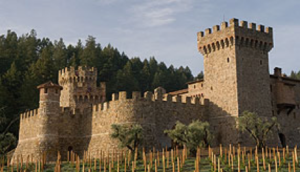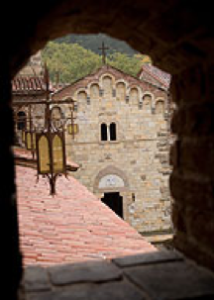
No discussion about the healthy state of the American imagination would be complete without talking about castles. Americans love castles and everything associated with them. In nearly every locale across the country, there are those who dream beyond the classic mansion or manor and build the medieval castle of their dreams.

Such dream castles are sometimes seen from the road atop some distant hill. However, rarely can one visit them. However, I had the opportunity to talk with a friend who told me of his visit to a medieval fairytale castle in the heart of Napa Valley. His narrative was so real that I almost felt that I had been there. It is a confirmation of the marvelous result what can be done when men dream.
It is called Castello di Amorosa, and it is a “medieval” castle-winery completed in 2007. It is on the crest of the hill surrounded by beautiful Napa Valley vineyards. My friend arranged a visit to the fortress and upon arrival met the castle owner in the Hall of the Knights.
The castle owner is Daryl Sattui. He is a man of passion that lives for more than money. He is part of a growing number of Americans who see great value in the traditions of the past.
Reviving the Family Business
Reviving the Family Business

Mr. Sattui is also a man who had a tradition to revive. He came from a family of vintners in Italy. His immigrant father was a winemaker in San Francisco whose career was cut short by Prohibition. Most of his early life was spent in gaining knowledge of making wine by traveling to Europe and working at Napa Valley wineries.
After gaining experience and skills, Mr. Sattui finally bought a winery, and after much hardship established himself on a property which he named after his great grandfather, the “V. Sattui Winery.”
From a four-acre vineyard with a European-style cheese shop and delicatessen, Mr. Sattui gradually acquired over 700 acres. More importantly, his reputation for producing excellent award-winning wines also grew over time.
Daring to Dream Even More
In 1993, Mr. Sattui bought a historic 171-acre property with a vineyard, forest and small lake. At first, he had no specific plans for the land other than producing some grapes for his winery. However, his enchantment for the setting soon gave rise to a dream to build something more.
What Does Saint Thomas Say About Immigration?
That “something more” was a building that would seek to satisfy yet another of his passions: a love of medieval architecture. Mr. Sattui did not quite know it yet, but he was on his way to building an authentic medieval castle.
An Organic Development
Like most things medieval, the plan for the castle developed organically and took years to idealize. After all, it is not easy to think about how to build a castle in a land of skyscrapers.

Mr. Sattui began making trips to Italy where he would visit abandoned places and castles. He took copious notes as he looked for ideas for his new project. Upon entering the abandoned properties, he would take measurements and draw sketches of what he saw. He acquired books on medieval castles, palaces and monasteries.
No Compromise in Building a Dream
Exploring old castles in Europe is very different from building them in California. It presupposes a search for materials and craftsmen that will make the new castle as authentic as possible. Mr. Sattui insisted on no compromise on materials and design since he would have nothing of Disney-like reproduction that he thought reeked of falsity.
Like everything he does, he sought out the best and most excellent to help him accomplish his dream. He once again traveled throughout Europe in search of those who would join him. He found people like Fritz Gruber, an Austrian master builder who specializes in making medieval-style wine cellars made from old bricks collected from former Hapsburg castles and palaces.
[like url=https://www.facebook.com/ReturnToOrder.org]
People like Mr. Gruber soon trained local workers with the Old-World skills to make his New World castle. They did things just like they would have been done in medieval times without modern tools and materials. At any given time during the fourteen-year building process, there were some twenty to sixty workmen from five different countries. Beneath the surface, they soon built a labyrinth of massive medieval cellars to house the winery wines. On top, Mr. Sattui constructed a marvelous castle.
A Real Castle
The result was Castello di Amorosa, a truly medieval castle with everything proper to a castle including a guardhouse, dry moat and drawbridge. It has high towers, crenelated walls and even an underground dungeon.

Mr. Sattui added yet more to the authenticity of the castle by combining several architectural styles to reflect a fortress that changed over the decades. Thus, the castle reflects several styles, the effects of war and constant remodeling. A person can read the whole history of the castle in the walls.
The Great Hall and the Hall of the Knights have frescos and paintings of medieval knights in all the splendor and pageantry. There is a large kitchen, servants’ quarters, stables and a bread oven. No detail is too small to have escaped being included.
Above all, the castle does not neglect the religious aspect of those medieval men, who put God at the center of everything. The castle boasts a large church complete with carved altar, beautiful frescos and even a confessional.
A Desire to Share the Things One Admires
Upon touring the castle, my friend sought to find out why Mr. Sattui had built it. He wondered what could have possibly motivated him to spend countless hours, researching, planning and building his medieval masterpiece.
Mr. Sattui found it difficult to express all the reasons for doing so much. He did say how impressed he was by the permanence, authenticity and beauty of the castles. He reflected upon how the medieval men built so much with such primitive technology.
What Does Saint Thomas Say About Marriage?

Perhaps the most important reason is that he wanted to share a vision that he passionately loved. He wanted to produce a thing of beauty not for himself but for all those who would come to visit and admire the castle. He even sacrificed retirement plans and savings to put together a place that would endure beyond his lifetime.
“If I can make somebody happy doing something,” he told my friend, “then it makes me feel good that I’ve done something with my life.”
In a sense, Castello di Amorosa belongs to all those who dream. It is a testimony, for all who share a vision of “building castles,” that such things can be done. And when this vision is inspired by Christian ideals, it is a real marvel that uplifts and captivates everyone to think of heavenly things.


